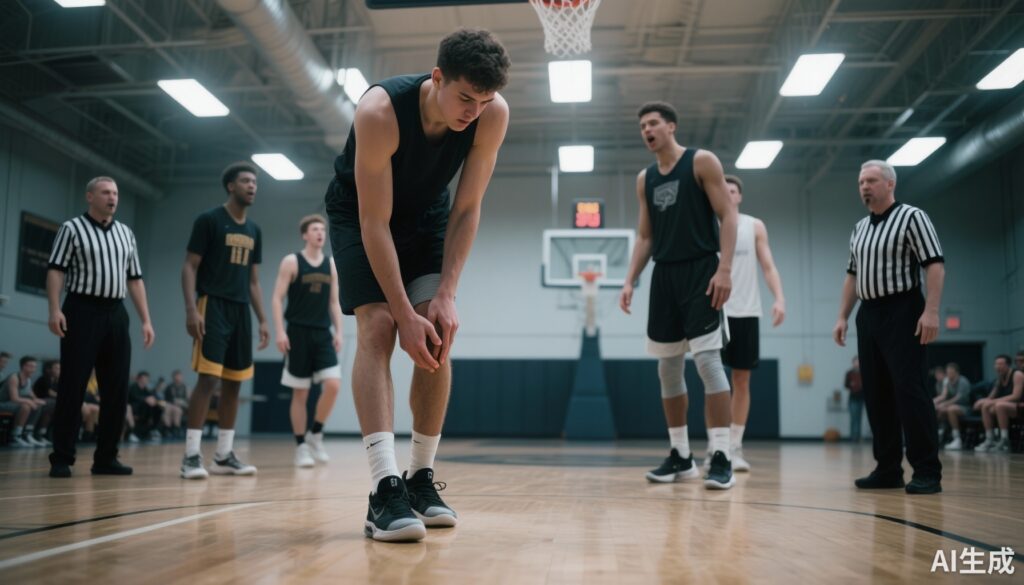Highlight
– Player contact (43%) and non-contact (25%) are the most frequent mechanisms; overall IRs were 0.156 and 0.093 per 100 athlete exposures (AEs), respectively.
– Ankle (25.8%) and knee (15.5%) injuries represent 41.3% of reported injuries (IRs 0.075 and 0.046 per 100 AEs).
– The commonest injury types were ligament sprains (IR 0.102/100 AEs), muscle/tendon strains (0.037/100 AEs), and concussions (0.028/100 AEs).
– Female players showed higher incidence rates for ball-contact injuries, knee injuries, dislocations/subluxations, and concussions; injuries were consistently more frequent in games than practices and higher at collegiate than high-school level.
Background and Clinical Context
Basketball is a widely played, high-intensity court sport that places repeated demands on the lower extremities and exposes players to frequent player-to-player contact, fast directional changes, and jumping/landing tasks. These exposures produce a measurable burden of acute and overuse injuries across age groups and playing levels. Quantifying injury incidence by mechanism, anatomical location, and injury type is essential for prioritizing preventive strategies, guiding targeted training interventions, informing sideline preparedness, and allocating medical resources across teams and institutions.
Study Design and Methods
The article by Stojanović et al. (2025) is a systematic review and meta-analysis that synthesized prospective and retrospective studies reporting injury incidence rates (IRs) in basketball players. Databases searched included PubMed, MEDLINE, and Google Scholar through October 2024. Eligible studies reported IRs calculated per number of athlete exposures (AEs) and/or per exposure hours. Twenty-two studies met inclusion criteria: 15 reported mechanism data, 21 reported body location data, and 17 reported injury-type data. Where available, subgroup analyses considered player sex (male versus female), playing level (e.g., collegiate vs high school), and exposure setting (games vs practices).
Key Findings
The pooled analyses from 22 studies produced the following principal findings.
Mechanism of Injury
Player contact accounted for 42.9% of injuries (IR = 0.156 per 100 AEs), making it the most common mechanism. Non-contact mechanisms comprised 25.0% (IR = 0.093 per 100 AEs). Ball contact and contact with equipment or the court were also observed contributors, with notable sex differences (see below).
Body Location
Ankle injuries were the most frequently reported (25.8% of injuries; pooled IR = 0.075 per 100 AEs), followed by knee injuries (15.5%; IR = 0.046 per 100 AEs). Together, ankle and knee injuries represented 41.3% of all reported injuries, underscoring the lower-limb predominance in basketball.
Type of Injury
Ligament sprains were the most common injury type (pooled IR = 0.102 per 100 AEs), followed by muscle/tendon strains (IR = 0.037 per 100 AEs). Concussion incidence was non-trivial (IR = 0.028 per 100 AEs), and head/face injuries constituted 16.3% of injuries, a proportion of particular concern among female athletes.
Sex Differences
Female players displayed higher IRs for specific categories: ball-contact injuries, knee injuries, dislocations/subluxations, and concussions. This sex disparity in knee injuries—often manifesting as increased ACL risk in females—aligns with prior literature indicating higher rates of some knee injuries in female athletes. The analysis suggests female players may also have distinct patterns of upper-body and head/facial injury that require tailored prevention and recognition strategies.
Setting and Level
Injury IR was consistently higher in game settings compared with practices, consistent with greater intensity, contact rates, and unpredictability during competitive play. Collegiate players demonstrated higher IRs than high-school cohorts, which may reflect greater game speed, physicality, and cumulative exposure, and/or differences in injury ascertainment and reporting.
Clinical and Practical Interpretation
The findings provide a contemporary, pooled estimate of where to target injury prevention in basketball. Practical implications include:
– Prioritize ankle and knee preventive programs. Given that ankle and knee injuries account for over 40% of injuries, structured neuromuscular training, proprioceptive work, and progressive landing and cutting drills should be core elements of warm-ups and season-long conditioning.
– Address both contact and non-contact mechanisms. While contact injuries are most frequent, a substantial proportion of injuries arise from non-contact movements — indicating benefit from neuromuscular training that reduces risky mechanics, particularly during cutting and landing.
– Female-specific prevention. The higher rates of knee injuries, dislocations/subluxations, and concussions in female players support implementing sex-tailored prevention programs (e.g., ACL-specific neuromuscular programs) and heightened concussion surveillance, education, and protective strategies.
– Game-focused risk mitigation. As injury IRs are higher during games, teams should optimize pre-game warm-up, on-court medical readiness, substitution strategies, and enforce rules that minimize dangerous contact.
Mechanistic Insights and Link to Prior Evidence
The pattern observed—lower extremity predominance and female vulnerability for knee injuries—mirrors longstanding biomechanical and epidemiologic data on basketball and other pivoting sports. Sex-related differences in neuromuscular control, landing mechanics, hormonal influences, and anatomic factors have been implicated in higher ACL and other knee injury rates among females (Arendt & Dick, 1995). That neuromuscular training reduces ACL risk in high-risk populations provides biological plausibility for targeted interventions (Mandelbaum et al., 2005).
Concussion rates and head/face injury proportions, particularly among females, underscore the need to apply contemporary concussion consensus approaches for recognition, management, and return-to-play, as delineated in international guidelines (McCrory et al., 2017).
Strengths and Limitations of the Evidence
Strengths of the meta-analysis include comprehensive database searching, pooling of contemporary studies, and stratified analyses by mechanism, location, type, sex, setting, and playing level. However, several limitations temper interpretation:
– Heterogeneity: Differences in injury definitions, surveillance methods, exposure denominators (AEs vs exposure-hours), and participant populations can create heterogeneity and influence pooled IR estimates.
– Variable reporting and under-ascertainment: Concussion and facial/head injuries may be underreported, especially in older datasets or where sideline medical staffing is limited.
– Limited granularity: Some studies did not disaggregate injuries by severity, recurrent versus new, or detailed subtypes (e.g., ACL vs. meniscal knee injuries), which constrains specific prevention and rehabilitation recommendations.
– Possible publication bias and geographic skew: Studies published in English and from certain regions may be overrepresented.
Implications for Practice, Policy, and Research
For team clinicians, athletic trainers, coaches, and sports policy makers, the following actions follow from the evidence:
– Implement and sustain evidence-based, sport-specific neuromuscular and proprioceptive training programs focused on ankle- and knee-injury prevention; ensure fidelity and progressive overload across the season.
– Expand concussion education, sideline screening, and standardized return-to-play protocols, with attention to female players who may be at higher reported risk.
– Prioritize game-day medical coverage and risk mitigation policies (e.g., officiating that limits dangerous contact, enforcement of rules protecting during rebounding and driving to the basket).
– Improve surveillance infrastructure to record exposure-hours, context, injury severity, recurrence, and long-term outcomes; adopt consistent definitions to allow future meta-analyses with less heterogeneity.
– Research priorities should include high-quality prospective cohorts with sex-stratified analyses, randomized evaluations of prevention programs in basketball settings, and studies addressing the mechanisms underpinning sex differences in head and facial injuries.
Expert Commentary and Guideline Context
Current international concussion guidance emphasizes the need for prompt recognition, graded return-to-play, and sex-aware monitoring (McCrory et al., 2017). For knee injury prevention, neuromuscular interventions have shown efficacy in young athletes in randomized trials (Mandelbaum et al., 2005), and their translation into routine basketball training is a logical step. The pooled epidemiology provided by Stojanović et al. (2025) helps prioritize these interventions by quantifying the relative burden attributable to anatomical sites and mechanisms.
Conclusion and Take-Home Messages
This systematic review and meta-analysis provides a contemporary synthesis of injury incidence in basketball players. Ankle and knee injuries are the dominant problem areas, player contact and non-contact mechanisms are both important, and female athletes appear to have higher incidence for several injury categories including knee injuries and concussions. Injury rates are higher during games and at higher competitive levels. The findings reinforce the need for evidence-based preventive strategies—especially neuromuscular training for lower-limb injury reduction—and improved surveillance and sex-specific approaches to reduce the burden of injury in basketball.
Funding and ClinicalTrials.gov
Funding details and clinical trial registration for the primary systematic review were reported in the original publication (Stojanović et al. 2025). Readers should consult the original article for specific funding declarations and protocol registration.
References
1. Stojanović E, Scanlan AT, Radovanović D, Jakovljević V, Živković V, Faude O, Fox J, Raasch K, Ferrauti A. Injury Incidence Rate According to Mechanism, Body Location, and Type in Basketball Players: A Systematic Review and Meta-Analysis. Sports Med. 2025 Oct 15. doi: 10.1007/s40279-025-02334-y. Epub ahead of print. PMID: 41091317.
2. Arendt E, Dick R. Knee injury patterns among men and women in collegiate basketball and soccer. Sports Med. 1995;19(4): 272–287.
3. Mandelbaum BR, Silvers HJ, Watanabe DS, Knarr JF, Thomas SD, Griffin LY, Kirkendall DT, Garrett WE Jr. Effectiveness of a neuromuscular and proprioceptive training program in preventing anterior cruciate ligament injuries in female athletes: 2-year follow-up. Am J Sports Med. 2005;33(7):1003–1010. (Note: commonly cited as evidence that targeted neuromuscular training reduces ACL injury risk.)
4. McCrory P, Meeuwisse W, Dvořák J, et al. Consensus statement on concussion in sport—the 5th International Conference on Concussion in Sport held in Berlin, October 2016. Br J Sports Med. 2017;51(11):838–847.



